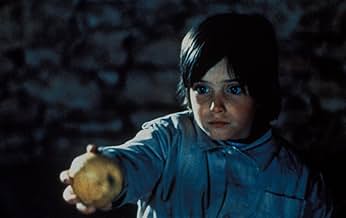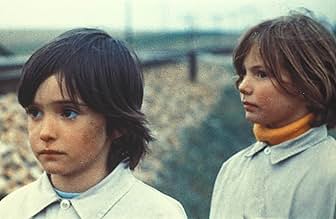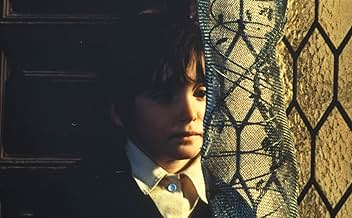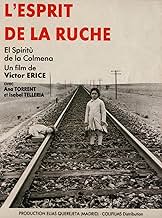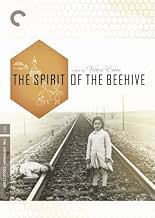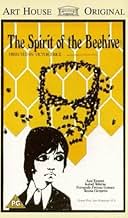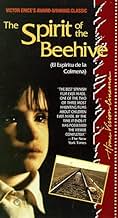Nella Spagna del 1940, dopo aver visto ed essere stato traumatizzato dal film "Frankenstein" (1931), una sensibile bambina di sette anni naviga nel proprio mondo fantastico.Nella Spagna del 1940, dopo aver visto ed essere stato traumatizzato dal film "Frankenstein" (1931), una sensibile bambina di sette anni naviga nel proprio mondo fantastico.Nella Spagna del 1940, dopo aver visto ed essere stato traumatizzato dal film "Frankenstein" (1931), una sensibile bambina di sette anni naviga nel proprio mondo fantastico.
- Regia
- Sceneggiatura
- Star
- Premi
- 7 vittorie e 1 candidatura in totale
Recensioni in evidenza
Many people here have mentioned the historical metaphors within the film but I won't delve into that, I thought the story was completely about the main character Ana.
First off, the actress who played Ana was very authentic, with a striking face full of emotion. She genuinely believed a lot of what was happening in the film including the Frankenstein monster being real! Such authenticity means it's worth seeing it for that alone and that is where the films true beauty lies...
For all this though, for what is essentially a beautifully shot film with great cinematography and performances, the film was a bit dull! It was only after the first 45 minutes or so that I started to wake up. There was a whole sub-plot between the parents marriage which I felt added little weight to the rest of the story.. There just wasn't a whole lot I felt I hadn't seen before.
So for me, I can see the film for what it was worth and why it received such accolades. But it was a little too dull for me to consider it "Great"
I recall one of my absolute favourite films ever The Fall, which also included a little girl who believed so much of the movie around her, that film was gripping from start to finish and never dull for a moment. Strange it hasn't gotten the praise it so deserved..
We can give an alternative name to this movie as "the spirit of the house", for the director tries to show what is going on in this house whose windows resemble to honeycombs. Erice deliberately chooses not to give any shots with all members of the family, as there is serious feeling of alienation between father and mother, and total lack of communication and affection between them, and from them towards their children. Under that situation the only person whom Ana could touch with her words, plays and questions is her sister Isabel. Their house looks like a beehive with the queen bee, male worker bee, and child bees performing their duties only by being in the same house without touching to each other.
When Ana's best friend and her sister played on her trust and fears by deceiving her, she totally turned inward and found the image and the dream of Frankenstein ready for her friendship and to give her feeling of closeness. After she met the wounded Republican soldier, her Frankenstein's image came into being in his existence, who is considered as dangerous and outside the society by adults just like in the original Frankenstein movie. Like the girl in the latter, Ana does not see the fugitive as how adults define Frankenstein, as something to be run away from. Instead, she considers him as Frankenstein who could be her friend. I see the shadow of the "monster" on this movie used beautifully and magically by the director.
During the 97 minutes of the movie, Erice and his cinematographer Luis Cuadrado both reflect the heart of a child to us with their magical scenes, and skillfully convey the grey feeling of the civil war in the background without straightforwardly pointing their fingers to it.
Ana Torrent is a wide-eyed innocent who carries the film, as we completely enter into how she integrates her daily life, both the quotidian happenings and the unusual, with scary stories her older sister teases her with and with the film. Her beautiful eyes are expressive and haunting. As someone who had an older sister with all kinds of outlandish tales that were gullibly believed, the sibling teasing is the most natural I've seen on film.
Erice has a completely original take on the Frankenstein story, no matter how many times it has been referenced in other movies. "Ana" powerfully relates to the little girl in the film, even though she does not understand any of the darker emotions or outcomes. The film inspires her to seek out misfits and outcasts, with unintended consequences and impacts on the adult world.
The adult world is the weakest part of the film, or it's so heavy with symbolism about the 1940's period when the film takes place or of the end of Francoism in Spain when the film was made that it's lost for a viewer first seeing the film today. While sometimes the parents', teachers' and servants' behavior seems mysterious if we were just seeing it from her perspective, their obliviousness and self-involvement in their own intellectual and romantic pursuits aren't really explained, even as her father's pompous hobby somehow gives the film its title. It might be some sort of commentary on how adults have their own way of blending fantasy and reality or some other political commentary.
Seen in a new 35 MM print at NYC's Film Forum, the cinematography by Luis Cuadrado was stunning. The rural scenes of fields, forest and horizon --where dangers and threats always lurk beneath the pastoral--are beautiful, with simply gorgeous looking vignettes of childhood experiences.
I wonder if this insightful look inside a child's mind influenced such films as "I'm Not Scared (Io non ho paura)" and "Paperhouse." but the film seems so fresh and creative I was surprised that it was made in 1973.
I found I had a strong empathy for the little girl who is trying to make sense of a story she has been told (in the movie) that has a powerful grip on her heart and imagination, and has an apparent connection with bigger, drastic events the real world, in a way she tries to understand.
I think it is really rather profound and affecting, even if you know nothing of Spanish history.
Lo sapevi?
- QuizCinematographer Luis Cuadrado was going blind at the time this film was made. An assistant would take Polaroids of the scenes and Cuadrado would direct the lighting by looking through a magnifying glass at these pictures. In 1980 Cuadrado committed suicide after he went completely blind and the tumor in his brain became too painful to face.
- BlooperWhen the fugitive jumps from the train and rolls down the hill, he's wearing boots, but in the next shot he's wearing low-cut shoes.
- Citazioni
Ana: [unable to sleep] Isabel?
Isabel: [opening her eyes] What?
Ana: [whispering] Tell me what you were going to tell me.
Isabel: [whispering] About what?
Ana: The movie.
Isabel: Not now... Tomorrow.
Ana: Now... You promised. Why did he kill the girl, and why did they kill him after that?... You don't know - you're a liar.
Isabel: They didn't kill him, and he didn't kill the girl.
Ana: How do you know? How do you know they didn't die?
Isabel: Everything in the movies is fake. It's all a trick. Besides, I've seen him alive.
Ana: Where?
Isabel: In a place I know near the village. People can't see him. He only comes out at night.
Ana: Is he a ghost?
Isabel: No, he's a spirit.
Isabel: Like the spirit Dona Lucia talks about?
Isabel: Yes, but spirits have no bodies. That's why you can't kill them.
Ana: But he had one in the movie. He had arms and feet. He had everything.
Isabel: It's a disguise they put on when they go outside...
Ana: If he only comes out at night, how can you talk to him?
Isabel: I told you he was a spirit. If you're his friend, you can talk to him whenever you want. Just close your eyes and call him... It's me, Ana... It's me Ana...
[they hear what sounds like ominous footsteps and are silent]
- ConnessioniFeatured in Sus años dorados (1980)
- Colonne sonoreOjos verdes
Written by Salvador Valverde (as Valverde), Rafael de León (as León) y Manuel L. Quiroga (as Quiroga)
I più visti
- How long is The Spirit of the Beehive?Powered by Alexa
- The flute/piano music is beautiful. Can anyone tell me the composer or the name of the piece?
Dettagli
- Data di uscita
- Paese di origine
- Sito ufficiale
- Lingua
- Celebre anche come
- The Spirit of the Beehive
- Luoghi delle riprese
- Hoyuelos, Segovia, Castilla y León, Spagna(Town and exteriors)
- Aziende produttrici
- Vedi altri crediti dell’azienda su IMDbPro
Botteghino
- Lordo in tutto il mondo
- 190.734 USD
- Tempo di esecuzione1 ora 38 minuti
- Mix di suoni
- Proporzioni
- 1.66 : 1
Contribuisci a questa pagina


![Guarda Tráiler [OV]](https://m.media-amazon.com/images/M/MV5BZDcyMjExODEtZGJlYy00MGNmLWJhZTItNzQ5MTNjNzAzNDQ2XkEyXkFqcGdeQXRyYW5zY29kZS13b3JrZmxvdw@@._V1_QL75_UX500_CR0)
